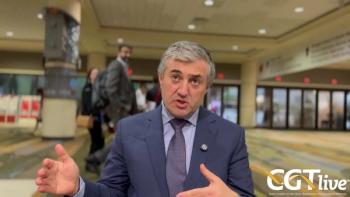
Ultrasound Guides Delivery of Interstitial Gene Therapy Gene Therapy for Prostate Cancer
CHICAGO-A preliminary study of interstitial gene therapy for recurrent prostate cancer shows that transrectal ultrasound can be used effectively for planning delivery of the agent and assessing its initial effects.
CHICAGOA preliminary study of interstitial gene therapy for recurrent prostate cancer shows that transrectal ultrasound can be used effectively for planning delivery of the agent and assessing its initial effects.
Transrectal ultrasound provides three-dimensional volume assessment of the prostate gland for planning the deposition of the gene therapy agent (PSA gene-regulated cytologic adenovirus), Ulrike M. Hamper, MD, said at the 85th Annual Meeting of the Radiological Society of North America (RSNA). It also allows real-time monitoring of the delivery of the virus into the gland and changes in histologic appearance after the virus has been deposited.
Dr. Hamper, associate professor of radiology and urology and director of ultrasound, Johns Hopkins Medical Institutions, reported initial results from a study of 30 men with prostate cancer that recurred locally after radiotherapy who are being monitored after receiving gene therapy.
The men underwent a treatment planning session involving transrectal ultrasound, which collected data for 3D modeling of the prostate prior to gene therapy delivery. The men subsequently received transperineal injection of the PSA gene-regulated adenovirus guided by transrec-tal ultrasound using a standard brachy-therapy template.
Color Doppler imaging performed on days 4, 22, and 90 after gene therapy delivery showed increased blood flow, compared with baseline levels, which likely is due to prostatitis arising from the effect of the virus on the prostate gland. Histologic examination revealed signs of tumor persistence in addition to acute and chronic inflammation.
PSA levels increased dramatically in 85% of men, which may be due to the acute destructive effect exerted by the virus on PSA-producing cells and the subsequent release of PSA by those cells, Dr. Hamper suggested. PSA levels on post-treatment day 22 were lower in 77% of men and unchanged in 1% of men. PSA levels increased by day 90 in approximately 50% of men, were stable in 1%, and declined in 40%.
Changes were more pronounced in men who received the highest viral dose. There was more vascularity in the prostate on days 4 and 22 and a greater drop in PSA levels in men who received the highest number of gene particles.
Further studies will assess the antitumor activity of the PSA gene-regulated adenovirus, evaluate the systemic bioavailability and distribution of the virus, and track the long-term effects of this form of gene therapy.
Newsletter
Stay at the forefront of cutting-edge science with CGT—your direct line to expert insights, breakthrough data, and real-time coverage of the latest advancements in cell and gene therapy.
















































